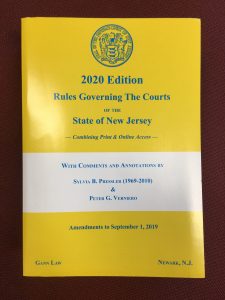In Amzler v. Amzler, (Docket No. A-3384-18), 2020 N.J. Super. LEXIS 38 (App. Div. 2020), the  Appellate Division provided direction on the effect of the September 2014 amendments to New Jersey’s alimony statute, N.J.S.A. 2A:34-23 as it relates to a litigant’s desire to retire before his full retirement age and stop paying alimony. Before the 2014 amendments, a party seeking to modify an alimony obligation was required to “demonstrate that changed circumstances have substantially impaired the ability to support himself or herself.” Landers v. Landers, 444 N.J. Super. 315, 320 (App. Div. 2016) (quoting Lepis v. Lepis, 83 N.J. 139, 157(1980)). The Legislature amended the alimony statute to add subsection (j), which applies in situation applies in situations involving “the prospective or actual retirement of the obligor.”
Appellate Division provided direction on the effect of the September 2014 amendments to New Jersey’s alimony statute, N.J.S.A. 2A:34-23 as it relates to a litigant’s desire to retire before his full retirement age and stop paying alimony. Before the 2014 amendments, a party seeking to modify an alimony obligation was required to “demonstrate that changed circumstances have substantially impaired the ability to support himself or herself.” Landers v. Landers, 444 N.J. Super. 315, 320 (App. Div. 2016) (quoting Lepis v. Lepis, 83 N.J. 139, 157(1980)). The Legislature amended the alimony statute to add subsection (j), which applies in situation applies in situations involving “the prospective or actual retirement of the obligor.”
In the Amzler case, the parties in 2009 signed a matrimonial settlement agreement (MSA) that required the plaintiff to pay alimony. The MSA contained an “anti-Lepis” provision, meaning that a “voluntary reduction in income of either party” would not constitute a substantial change in circumstance for the purpose of reviewing alimony. After the parties’ divorce, the plaintiff continued to work, but due to medical reasons, retired before reaching full retirement age. The defendant filed a motion seeking to enforce the MSA and the plaintiff’s alimony obligation; the plaintiff filed a cross motion seeking to terminate or reduce his alimony obligation due to his retirement.
The trial court granted the plaintiff’s motion to terminate alimony, relying on section N.J.S.A. 2A:34-23(j)(2) of the alimony statute, which applies when a payor spouse retires before reaching full-retirement age. The defendant argued that the judge incorrectly applied subjection (j)(2) of the statute rather than subsection (j)(3), which governs the review of final alimony orders or agreements that were established before the effective date of the 2014 statutory amendments.
 New Jersey Divorce and Family Lawyer Blog
New Jersey Divorce and Family Lawyer Blog






